#nanobots 2013
Explore tagged Tumblr posts
Text
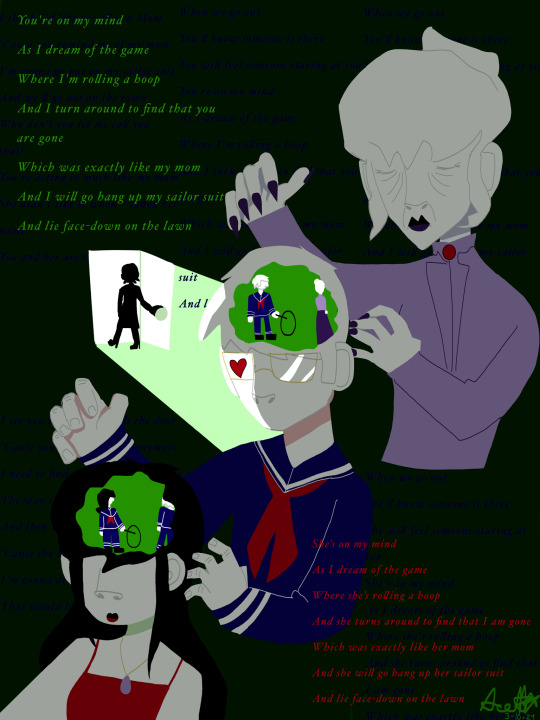
bro thought the oedipus complex was for ONE DAY ONLY!!!! HE MAD!!!! 🤣🤣🤣🤣 reposting this on mothers day
#strideryourself#isopodretina#they might be giants#tmbg#art#tmbg fanart#nanobots#nanobots 2013#call you mom tmbg#nanobots tmbg#tmbg nanobots#would it be funny to tag oedipus complex
9 notes
·
View notes
Text
transcript:
JF: so to wrap things up, we’ll end things fittingly with a very short song off our brand-new album, "Nanobots". this song is called "Hive Mind". it's sex- suh- it's six seconds long.
JL: it's sexy.
JF: it's - six seconds long. [JL laughing]
JL: you wanna say it again?
JF: should I do that--?
JL: -- I don't know if that was clean.
JF: should I do that- should I do that whole thing--?
JL: just say the ex- the end again.
JF: OK. it's six seconds lon- god, that's [fucking] hard to say.
#when the og site has a transcript already <3#this full little piece is great so recommend clicking through!#tmbg#they might be giants#john flansburgh#john linnell#2010s#nanobots#interviews#podcasts#audio
73 notes
·
View notes
Text
“Not everyone you’ve abandoned is still standing by, not everyone who is lost is wondering why.”
Sometimes A Lonely Way - They Might Be Giants - Nanobots (2013)
#sad one today im going thru some heavy shit#nanobots#they might be giants#tmbg#plilfsfail#posting lyrics i like from songs from albums i like
13 notes
·
View notes
Text
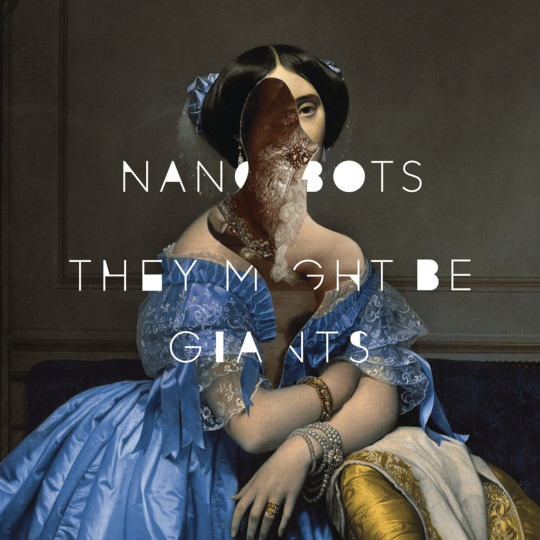
TMBG Song of the Day 25.07.10
You're on Fire Nanobots (2013)
"You're hard to get to know, But you're easy to spot in a crowd"
youtube
7 notes
·
View notes
Text
was so excited about going pro that in the hubris lost every person place and thing
lost my pronouns:(
27 notes
·
View notes
Text
No, but seriously, how do you think Clint's other friends and the Avengers feel about Shield poaching Avengers via nanobots? Like we have Maria Hill litwrally says this, with no exploration of this and how deeply disturbing this; and we additionally treat this like it is CHILL.
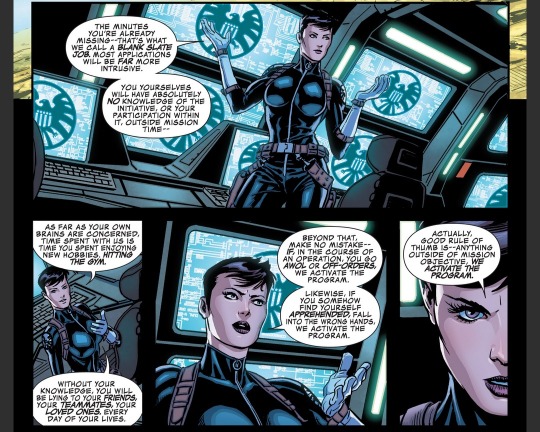
Secret Avengers vol 2, issue 1.
And then when in addition you add this to my inspired headcanon (with sources for support) of Clint being an alcoholic and struggling with alcoholism, and writing my own recovery arc for him post Freefall. Considering this is 2013, alongside Fraction's run which is a great comic issue to point at and say "hey signs of alcoholism" which if you aren't overly familiar with addiction as a disease; memory loss is a part of it, a huge part of that, and to add this on top of Clint showing signs of alcoholism and drinking a six pack plus in one night behavior (fraction's run, don't have the issue number, but it's after gil died / additionally all new hawkeye has panels displaying him drink multiple beers a night ) like hello? hello? Marvel, can we address this? Can we acknowledge clint's traumas and addictions, and this-
Are the nanobots and memory implants still in his brain? Can the avengers be upset this was done to their friends who literally no ability to say no or remember?
6 notes
·
View notes
Text
so i have these TMBG CDs so far:
No! (2002, Idlewild/Rounder release)
I Like Fun (2018, Idlewild/Megaforce release)
Nanobots (2013, Idlewild/Lojinx release which is apparently the UK release for some reason?? Even though I live in the US!!! Actually thats kinda cool ngl-)
the Pink Album (1987, Bar None/Restless)
(hopefully) 1 other that supposedly hasnt come in yet.
That one other may be one of these:
Lincoln
Flood
Apollo 18
Miscellaneous T
Something else I'm unaware of
I'm thinking if i get a dvd player set up at some point soon (or even an external disc drive for my computer) I may see if I can get Direct from Brooklyn (DVD, I think it's from 1999) someday
My CD player has a cassette deck too so I might as well acknowledge that somehow
#tmbg#berryzbabblez#i have a collection now....#GRINS EVILLY#berry's physical media collection#<- new tag woohoo#this applies to my cd and or dvd collection in general#not just the tmbg stuff
2 notes
·
View notes
Text
sometimes i still seethe about the tall guys in front of me at the they might be giants show who just politely listened to anything not off flood
when they played nanobots one leaned over to the other and said "i guess they gotta play the new stuff too huh" nanobots came out in 2013 you FUCKS let me stand there
1 note
·
View note
Text
AI predictions from 2010 to 2015: How close are we?
In 2013, Wired magazine predicted that AI could help predict which flu virus would cause the next deadly human outbreak. This prediction has come true to some extent, as AI is now being used to monitor emerging flu strains and predict their impact. However, AI's role in the COVID-19 pandemic has been limited.
In 2018, CNBC predicted that AI would result in mass unemployment. This prediction has not come true, as AI has actually created more jobs than it has destroyed.
In 2016, TIME Magazine predicted that "smart machines" would be working alongside humans in the workplace. This prediction is underway, as AI is already being used in many industries, including healthcare, retail, and gaming.
In 2015, Ray Kurzweil made several predictions about the future of AI, including:
By the late 2010s, glasses will beam images directly onto the retina. This prediction has not come true yet, but there are several companies working on developing this technology.
Ten terabytes of computing power (roughly the same as the human brain) will cost about $1,000. This prediction has come true.
By the 2020s, most diseases will go away as nanobots become smarter than current medical technology. This prediction has not come true yet.
Normal human eating can be replaced by nanosystems. This prediction has not come true yet.
The Turing test begins to be passable. This prediction has come true, as several AI systems have now passed the Turing test.
Self-driving cars begin to take over the roads, and people won't be allowed to drive on highways. This prediction is slowly coming true, as self-driving cars are becoming more and more sophisticated.
In 2018, Forbes predicted that there would be a move towards "transparent AI" and useful AI assistants. This prediction has come true to some extent, as there is a growing demand for transparency in AI, and AI assistants are becoming increasingly useful.
Overall, the predictions about AI from 2010 to 2015 have been mixed. Some predictions have come true, while others have not. However, it is clear that AI is having a profound impact on our world, and it will continue to do so in the years to come.
https://blog.re-work.co/revisiting-old-ai-predictions/
0 notes
Text
They Might Be Giants
Nanobots tour @ the Warfield, SF
a great time! even if i hadn't listened to them much since college

https://www.setlist.fm/setlist/they-might-be-giants/2013/the-warfield-san-francisco-ca-bd9d1f2.html
added 9/27/23
0 notes
Text
I'll elaborate with examples from They Might Be Giants music, because who else would I use.
Mundanely Dismal - Songs describing the most dismal things imaginable using mundane or innocuous imagery.
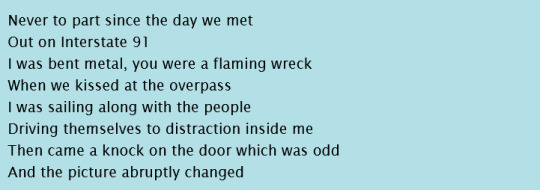
The End Of The Tour (John Henry, 1994)
There IS a bit of mention of the actual subject matter through "flaming wreck" and "bent metal", but I am more focused on the bizarre metaphor of the mundane act of kissing to describe a fatal car accident.
Surreally Mundane - Describing plain, mundane concepts in the most insane way imaginable.
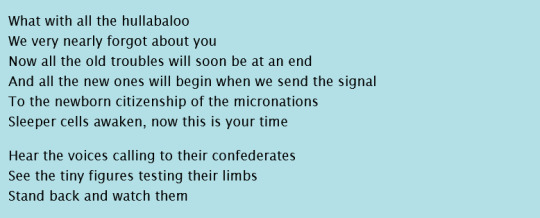
Nanobots (Nanobots, 2013)
The entire point of this song is comparing Actual Real Human child rearing to repeatedly dividing well. Nanobots. I just think "the newborn citizenship of the micronations" is a funny and bizarre way to describe children, something John Linnell probably thought of a lot as a parent.
Get A Load Of This Guy - Weird ass guy. Or Girl. Or whoever else. Get a load of them. haha aren't they strange. Anyway

Icky (Nanobots, 2013)
This one's pretty straightforward. It's just a song about Some Guy. There are a billion examples I used, this is just the first one that came to mind.
Anyway, I think it would be fun if everyone picked one artist and reblogged with 3 songs of theirs that fit the three points lol
As far as I'm concerned, there's only three genres of song lyrics:
Mundanely Dismal
Surreally Mundane
Get a load of this guy
#two songs from nanobots. Weird.#no particular significance to that fact it was just a coincidence lol#they might be giants#songwriting#resources
50 notes
·
View notes
Text
hour 2 of pour outage. im listening to nanobots and i think chica fnaf is gonna get me. withered chica. from fnaf 2 stingray.
stone cold coup d’etat - 10/10
1 note
·
View note
Text
transcript:
[crowd cheering]
JL: we have a brand new album out! um.
JF: BRAND NEW!
JL: we're very, very excited!
JF: yeah!
JL: it's so new, that its mother is still licking its fur. and its eyes are not open. [laughter] but! it's, uh- you can listen to it, now, anyway.
#the image of a little nanobots album cub ..#tmbg#they might be giants#john linnell#john flansburgh#2010s#nanobots#shows#audio
36 notes
·
View notes
Text
sometimes an album is not an album, she's my girlfriend
#this post is about nanobots (2013) do not derail!!!!! i mean you can if you want... death of the blogger and all that#my posts
7 notes
·
View notes
Text
booty shorts that say NANOBOTS 2013
booty shorts that say THEY MIGHT BE GIANTS
9 notes
·
View notes
Text
Aetherpunk
By a member of the Duck Prints Press staff who has chosen to be anonymous.
Note: Punk genres are diverse and always changing. Duck Prints Press is not trying to give a complete explanation of aetherpunk here but rather a bit of inspiration. Take what you want from it to create your own aetherpunk worlds!
On January 5th, Duck Prints Press will be launching recruitment for our next anthology: Aether Beyond the Binary, a collection of stories featuring main characters outside the gender binary living in modern or near-future aetherpunk Earth! This begs the question: what IS Aetherpunk? Well, read on and learn all about it…
Prologue: From the Aether
Scenes from the Aether #1: Bloomington, Indiana, 2013:
Lin steps into the café down the street from their apartment. The lights of the shop glow a pleasant green, reminiscent of the owner’s own magical aura. Soon, when Del opens the shop for customers, they’ll turn a more standard blue, but for now Del’s shop is cozy and quiet. Lin smiles, looking forward to seeing their friend.
A shower of blue sparks flies from the kitchen’s open door, and Del scrambles out, cursing. When he sees Lin, he breaks into a wry smile.
“Breakfast on the house?” he offers, his shorthand for pleading.
“That’s the third time this week,” Lin chides, barely holding back their smile. They roll up their sleeves to go tinker with Del’s new, “improved” baking oven. “Why not use your old one?”
“The aether this model uses is supposed to be more efficient!” Del exclaims. Then, with a sad smile: “Plus no one trusts my powers. They still think the color’s associated with… you know.”
“Yeah.” Lin knows. They think of Del’s infamous brother, the deadly alchemist. “I’ll help you, but this is the last time.”
“Mhm,” Del says, nudging Lin’s shoulder, and adds telepathically, You say that every time.
You could try not being so smug about it, Lin half scolds, half laughs.
“Why wouldn’t I be smug? My handsome, brilliant friend, the undisputed genius of the IU School of Aetheric Engineering, is fixing my pipes for free.”
Lin blushes but maintains their chiding tone as they say, their warm face hidden behind the stove where the power supply has once again leaked from its pipes, “Not for free. For breakfast.”
Part One: What’s in a Punk (genre)?
There’s been an explosion of punk genres since Bruce Bethke’s 1983 story Cyberpunk launched the genre. Though Bethke’s story may have given a name to this phenomenon, in his Etymology of “Cyberpunk” Bethke credits William Gibson’s Neuromancer (1984) for really defining the core tenets of the genre (Bethke, 2000). He also marvels at how the cyberpunk character trope (“a young, technologically facile, ethically vacuous, computer-adept vandal or criminal”) has stayed remarkably stable over the years since his story was published. In 2022, when I’m writing this, it’s still very similar. The cyberpunks in the cyberpunk genre are the sorts of lone heroes who often arise in the isolating environments fostered by advanced computer technologies.
Why am I rambling on about cyberpunk? Because, dear readers, cyberpunk is the progenitor of all genrepunks. As the most widely explored and utilized punk setting, it has provided the blueprint on which other punk genres are built. In essence, every punk after cyberpunk is a reaction to cyberpunk, either embracing or pushing back against its ethos. After cyberpunk came steampunk: a retro, adventurous answer to cyberpunk’s gritty and dystopian futurism. Then came others: dieselpunk, sandalpunk, biopunk—even the very meta “mythpunk” to which Neil Gaiman’s work is often attributed. These days, even non-punk fantasy is often punk-adjacent.
So what makes punk stories… punk? For a story to be classified in a punk genre, it typically requires two key elements: a distinctive type of technology (whether social technology like myths and lore or physical technology like steam engines, diesel-powered airships, or nanobots) and a point of view about that technology.
The technological distinctions can seem fairly obvious: atompunk features tech powered by nuclear energy; nanopunk, tiny robot technology; biopunk, genetic engineering and biotech; dieselpunk, diesel-powered machines. But focusing on only the tech aspects can make people miss the point of having multiple different punk subgenres.
Take this paraphrased version of a forum conversation, circa 2015:
[User 1]: Hey, I’ve been hearing more and more about this genre called ‘aetherpunk,’ but I can’t figure out what it is. How is it different from just steampunk but with magic?
[User 2]: Sorry to tell you, friend, but it’s basically just “steampunk with magic.”
[User 1]: Ah. So, completely useless, then.
This view is common but misses the point. The tech alone does not make punk punk. The second necessary element is the cultural context of the technology: how does it affect the people who use it every day? How dissociated do those people feel from their environment? From their government? From the inevitable march of society, driven at least partially by technological advances using the genre-specific tech? Punk genres live and breathe for their exploration of the intersection between technology and culture.
Genreunk is a response to the world we live in. Cultural evolution happens when technologies—lore, steam engines, printing presses, atomic bombs—intersect with cultural habits and traditions and shake them loose. We don’t live in the only, or the best, possible world. When we write punk, in some ways, we’re rewriting cultural evolution. We’re asking for a new way of thinking about the past and how that carries forward into the future. How we would be different. How we would be the same.
Punk isn’t just a genre. It’s a tool for understanding humanity.
Part Two: Clear Air, a History of Aether
In the beginning, gods breathed their essence into the emptiness of space, and aether entered the universe as the material through which the stars and planets moved. Humans in ancient Greece, attuned to this invisible presence, named it “clear air” and declared it the fifth element, along with earth, water, air, and fire. Other cultures gave this energy different names or didn’t name it at all but nonetheless knew it was there. Over a thousand years later, medieval Europeans called it “quintessence” and hypothesized that this element, rare on Earth, could be distilled in order to cure mortal ailments. Aether was a substance that could make rocks burn and lights glow. It became a key ingredient in classic alchemical experiments in the West.
Aether has always been the bringer of light, the unchanging medium through which energy travels in waves from its source to the lenses of our eyes, to the leaves of hungry plants, to everywhere on the planet and throughout the universe. Indeed, it was so recently believed in and well-known that late 19th-century spiritualists took photos of ectoplasm and declared that ghosts could send messages through the aether.
Then, a mere hundred-odd years ago, we lost faith.
The idea of aether seems preposterous now, when we know about electron fields and the theory of relativity which states that nothing in the universe is stable or unchanging (and we certainly don’t need a special medium that exists to move light around)—but is it really so much harder to believe in aether than in electron fields? Or in dark matter?
Why shouldn’t we be swimming through aether like a fish swims through water?
Part Three: What is Aether/Punk?
Aetherpunk, the genre, explores what the world would be like if, rather than finding out aether was simply a confused explanation for how energy moves through space, we discovered that it was a real element, something we could both detect and harness. The nature of the aether isn’t what makes aetherpunk what it is. Rather, it’s the exploration of the development of society from the turning point when we discover that the aether is real—how that changes the world, the people, the past, and the future.
Aether, the invisible force, can be everything and nothing. It can be magic, or it can be material. In some disciplines, like alchemy, it’s both. Aether is made of faith. It’s ephemeral, often immaterial, and only visible once the viewer knows what they’re looking for. It can cause disaster or provide beautiful, clean energy for wondrous technologies. It can be a source of progress or of fear. But in the end, it’s still a thing that must be discovered and cultivated. It can’t be forced into existence.
Aetherpunk as a genre is more naturistic than earlier punk genres like steampunk or cyberpunk. Natural materials find their way into clothing and buildings and weapons and tools, and the shapes of these man-made elements are designed in ways that enhance their ability to harness aetheric power. There might be constructs of stone or finely-honed metal held together by aetheric energy, beautiful steel weapons that cut through stone using atom-thick edges of pure aether, skyships and buildings of gold, or of clear stone, or of glass and crystal. And the technology bathes its surroundings in a luminous glow of aetheric light.
Like solarpunk and lunarpunk, aetherpunk is a hopeful punk genre. When aether is discovered and harnessed, it brings about flourishing communities and can help to heal the world. Of course there are dark sides—the dangers of a volatile power source that not everyone can control, the frustrations of the people who are unable to use that power for themselves—and anyone is welcome to write a dark aetherpunk story. But aetherpunk doesn’t come with the same inherent baggage as steampunk or cyberpunk. Likewise, people can write utopian steampunk and cyberpunk, but that’s the opposite of the “standard” core of the genre. Aetherpunk wants to explore humanity in a universe where we don’t struggle simply to light our homes. Where the power that runs everything suffuses the universe, and therefore everyone can reap the benefits. A world where our source of power doesn’t send millions of people to an early grave. What sorts of stories would emerge in this sort of world?
Part Four: Steampunk but with Aether?
Now that we’ve described what aetherpunk is, let’s return to that dreadful forum post, and ask for ourselves: what makes aetherpunk more than just “steampunk but with aether”?
In short, everything.
First is the nature of the energy that powers the technology. Steampunk is a retrofuturistic genre that centers on the era when steam, fueled by wood and coal, was the main power source, around the turn of the 1800s during the Industrial Revolution. It harkens back to the aesthetics of the era, with wood and steel and glass materials, wooden ships that ply the air, clockworks and rivets and tangible, heavy things that work through sheer force. Steam is a thing with weight. It will melt your flesh from your bones, and it’s born not of faith, nor internal strength, nor the careful distillation of spirits down to their quintessence, but instead through fire. Another resource needs to burn to make it. Entire lives are spent feeding coal into the voracious maws of steam engines.
Aetherpunk, as we’ve described, is born of magic, and thus the technology to use it focuses on cultivation and focusing energy rather than on producing something by force. Even the most cursory look at the nature of the energy source shows us how every aspect of society linked with producing that energy is different between steampunk stories and aetherpunk stories.
There’s also a very important cultural distinction between aetheric stories and steam-powered stories. In steampunk, the adventures of sky pirates and nobility are built on the efforts of a vast lower class who are systematically shut out from steam’s benefits. It may not matter to the story at hand, but the underlying class tension is always there. Like cyberpunk, steampunk takes inequality as a given, and places singular heroes into that world.
Aetherpunk is more utopian and egalitarian. There’s no assumption built in that in order for a person to use their magical flying ship, someone else must suffer to create the energy needed to fuel it. This distinction makes all the difference in how aetherpunk and steampunk stories are told.
In either case, the power source can be wonderful or terrible, can fuel dystopian nightmares or hopeful solutions to the troubles that ail the world. But the fundamental nature of these technologies affects the way characters think and speak about the world they inhabit. Is it a place of smog or of shimmering lights? Is it a place where magic competes with technology, or is it a place where magic is the technology? The answers to these questions are different in every punk genre, and those differences should have a profound impact on the story’s narrative.
Where will your aetherpunk story take you?
Epilogue: From the Aether
Scenes from the Aether #2: San Francisco, 2043
Shining, multicolored bridges bend but do not break in the powerful earthquake that, in previous eras, would have shaken buildings from their foundations and dropped bridges into the bay. Drivers and pedestrians cling to whatever safety they can as the structures sag and sway and finally, after all is done, snap back to form as though the past minute was only a bad dream.
Trill breathes a ragged sigh before stepping back onto zir motorcycle and kicking the starter. A blue glow and a warm hum are the only signs that the bike is powering up before Trill finishes crossing the bridge, a little jumpy from the unexpected shaking but no worse for wear. Ze has a long way still to go before ze arrive at Heloise’s house. Ze can’t wait to see zir friend, who is finally home after her long trip to Lima where she was training magicians to harness their power.
Trill rides north into the mountains while the sun sets to zir west, out above the ocean, and the world glows orange and pink. By the time ze powers down zir bike, the sky is silky black and filled with stars. Trill climbs toward Heloise’s small house, which is built into the slope; the soft blue glow of natural aether in the rocks lights the way. Ze knocks on Heloise’s wooden door; Heloise answers with a hug around Trill’s waist, her face pressed into Trill’s chest. Trill laughs, something in zir heart finally relaxing.
It’s been a long eight months.
She pulls Trill inside, into this warm place she’s made in the lonely hills above the bay, and even though ze doesn’t deserve it, Trill revels in her welcome. It feels like coming home.
Examples of Aetherpunk
As aetherpunk is a young genre, examples are sparse, and there are many opinions on what “counts” and what doesn’t. For example, some people consider Lord of the Rings to be aetherpunk, due to the way it brings magic and technology together (especially in Mordor and in Sarumon’s plot line) and the way the magic interacts with society. The below list should not be considered exhaustive, just as this post shouldn’t be treated as The Last Word on the nature of aetherpunk.
Books:
The Aether Chronicles by Abi Barden
Aether Frontier by Scott McCoskey
Chasing the Lantern by Jonathon Burgess
Strange Skies by Loud Silence
Games:
Eberron
Final Fantasy
Genshin Impact
League of Legends
Magic the Gathering (specifically the Kaladesh Plane)
Xenoblade Chronicles
About Duck Prints Press
Duck Prints Press LLC is an independent publisher based in New York State. Our founding vision is to help fanfiction authors navigate the complex process of bringing their original works from first draft to print, culminating in publishing their work under our imprint. We are particularly dedicated to working with queer authors and publishing stories featuring characters from across the LGBTQIA+ spectrum.
Love what we do? Sign up for our monthly newsletter and get previews, behind-the-scenes information, coupons, and more!
Want to support the Press, read about us behind-the-scenes, learn about what’s coming down the pipeline, get exclusive teasers, and claim free stories? Back us on Patreon or ko-fi monthly and read your fill!
Sources
r/aetherpunk on reddit
“Different Punk: A to Z of Punk Genres,” April 30 2019, by Isaac
“The Etymology of ‘Cyberpunk’ ” by Bruce Bethke
“Please Define ‘Aetherpunk,’ ” November 15 2015, by Union Jacknnife and Nostil.
“Something is Broken in Our Science Fiction,” January 15 2019, by Lee Konstantinou
#duck prints press#aether beyond the binary#coming soon#aetherpunk#what is aetherpunk#weekly blog post#guest blogger#our titles#original content
45 notes
·
View notes